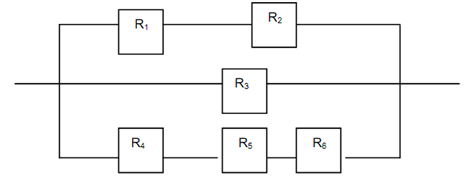Combined (Series and Parallel) System
It is a combination of series and parallel systems.
In such cases of a system having elements connected both in parallel and series, it is better to convert into one of the systems. Two cases are illustrated as shown below in the Figures
Here in this case we convert the parallel system into equivalent series system, so that the whole system turns to series type only.

Figure: Combined System - Case 1
In the above system, we consider that we have a series system with (A parallel subsystem of R1, R2, R3), R4, R5, (A parallel sub system of R6, R7) and R8, where first, we shall calculate the reliability of the sub systems as follows:
{1 - (1 - R1) (1 - R2) (1 - R3)} = Rx say
And {1 - (1 - R6) (1 - R7)} = Ry say
Then the overall system reliability is given by
R = Rx. R4. R5. Ry. R8
= {1 - (1 - R1) (1 - R2) (1 - R3)} R4. R5. {1 - (1 - R6) (1 - R7). R8}
Consider the case of combined system as shown in Figure 9.8. In this case it is better to convert the components into equivalent parallel system. Here we shall consider the three subsystems as parallel. The top sub system and bottom subsystems are having the components in series. Thus we consider as a parallel system of (A series subsystem of R1, R2), R3 and (A series subsystem of R4, R5, R6).

Figure: Combined System - Case 2
Thus the overall reliability can be computed as
For series subsystem of R1, R2, it is Say Rx = R1 × R2
For series subsystem of R4, R5, R6, it is Say Ry = R4 × R5 × R6
The overall System reliability is
R = 1 - (1 - R1 × R2). (1- R3). (1 - R4 × R5 × R6)
= 1 - (1 - R1 × R2). (1-R3). (1 - R4 × R5 × R6)